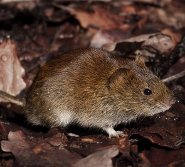 The Bank vole (Clethrionomys glareolus), or more recently, Myodes glareolus is a small rodent belonging to the second largest family of mammals. This vole can be found throughout Eastern and Western Europe, including England, Spain, Italy, Finland, as well as Northern Asia, more specifically in the Ural region. However, the species is considered invasive in Ireland after their accidental introduction in the 1950s.
The Bank vole (Clethrionomys glareolus), or more recently, Myodes glareolus is a small rodent belonging to the second largest family of mammals. This vole can be found throughout Eastern and Western Europe, including England, Spain, Italy, Finland, as well as Northern Asia, more specifically in the Ural region. However, the species is considered invasive in Ireland after their accidental introduction in the 1950s.M. glareolus thrive among large ferns, dense hedges, and brambles, as well as in woodland habitats characterized by sunny, open-canopy forests, grasses, and herbaceous plants. They are commonly found on riverbanks and in gardens. These voles construct underground nests lined with moss, grass, and feathers, and fill these nest chambers with food caches containing insects, nuts, lichens, buds, and leaves. Bank voles climb bushes, tree roots, and low branches while foraging.
Bank vole social structures center on female territories. Male home ranges are larger than female ranges and generally overlap with more than one female territory at a time. Bank voles live for a maximum of eighteen months, though many die soon after birth. Approximately half of their lifespan makes up the breeding season, running from March to October, and peaking in June. Bank voles reach sexual maturity after approximately three months, and females give birth to five or six litters a year, with three to six voles in a litter.
Bank voles serve as hosts to a variety of ecto- and endoparasites. Notably, these voles have been shown to harbor four species of nematodes, one species of flea, and at least two species of tapeworms. Predators of M. glareolus include least weasels, tawny owls, foxes, pine martens, and stoats. Predators tend to target larger, reproductively active voles. Bank voles do not exhibit strong anti-predatory behaviors in response to mink. In particular, the highly territorial females tend to stay within their ranges instead of seeking cover. Despite such rampant parasitism and predation, bank voles are in no way endangered; the International Union for the Conservation of Nature has marked their conservation status as of "least concern".
Picture of the bank vole by Evan James hymo, licensed under Creative Commons Attribution 3.0 Unported license.
The Bank vole is listed as Least Concern (LR/lc), lowest risk. Does not qualify for a more at risk category. Widespread and abundant taxa are included in this category, on the IUCN Red List of Threatened Species
Bank vole habitats
Subarctic forestSome facts about the
Red-backed mouse
Adult weight : 0.021 kg (0.0462 lbs)
Maximum longevity : 5 years
Female maturity :47 days
Male maturity : 72 days
Gestation : 20 days
Weaning : 20 days
Litter size : 4
Litters per year : 3
Interval between litters : 21 days
Weight at birth : 0.002 kg (0.0044 lbs)
Weight at weaning : 0.01 kg (0.022 lbs)
Body mass : 0.022 kg (0.0484 lbs)

Custom Search